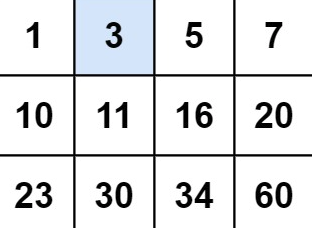Hi 大家好,昨天將binary search的題目分成三個類型:
今天就要從第一個類型開始介紹起,讓我們開始吧
題目敘述:有一個遞增的array,給予某個整數當作要從這個array中找出的目標。題目要求要找出符合這個目標且最左邊的index和最右邊的index。找不到目標時回傳-1。
Example1:
Input: nums = [5,7,7,8,8,10], target = 8
Output: [3,4]
Example2:
Input: nums = [5,7,7,8,8,10], target = 6
Output: [-1,-1]
分析:
以下是原本的binary search程式碼,
def binarySearch(arr, target):
l, r = 0, len(arr) - 1
while l <= r:
mid = (l + r) // 2
if target > arr[mid]:
l = mid + 1
elif target < arr[mid]:
r = mid - 1
else:
return mid
return -1
對於第一型,根據條件來回傳不同的index的題目只要把握更改else裡的程式碼以及l = mid + 1,代表我們要將找尋的範圍往右移,所以會找到靠右邊的index;r = mid - 1,代表我們將找尋範圍往左移,所以會找到靠左邊的index。
class Solution:
def searchRange(self, nums: List[int], target: int) -> List[int]:
def binarySearch(target, leftBias):
l, r = 0, len(nums) - 1
res = -1
while l <= r:
m = (l + r) // 2
if target > nums[m]:
l = m + 1
elif target < nums[m]:
r = m - 1
else:
res = m
if leftBias:
r = m - 1
else:
l = m + 1
return res
ans = []
ans.append(binarySearch(target, True))
ans.append(binarySearch(target, False))
return ans
因為要找出靠最左和最右邊的index,所以我們利用LeftBias來當作開關,leftBias為True代表要找出靠左的index。
def insert_in_left_or_right(nums, target, leftBias):
l, r = 0, len(nums) - 1
while l <= r:
m = (l + r) // 2
if target > nums[m]:
l = m + 1
elif target < nums[m]:
r = m - 1
else:
if leftBias:
r = m - 1
else:
l = m + 1
return l if leftBias else r
# Example:
sorted_array = [1, 3, 3, 4, 4, 4, 5, 6]
target = 4
first_index = insert_in_left_or_right(sorted_array, target, True)
last_index = insert_in_left_or_right(sorted_array, target, False)
print(f"The target {target} should be inserted before index {first_index}")
print(f"The target {target} should be inserted after index {last_index}")
The target 4 should be inserted before index 3
The target 4 should be inserted after index 5
題目敘述:給予一個 m x n的整數陣列,並且有以下特點:
需要一個O(log(m * n))的解答
Example:
Input: matrix = [[1,3,5,7],[10,11,16,20],[23,30,34,60]], target = 3
Output: true
第二型會和平時的一維陣列不同的資料結構上使用binary search,像是本題是二維陣列。本題只需要將二維陣列拆解成m個一維陣列,並且在此執行binary search就可以得到答案。
class Solution:
def searchMatrix(self, matrix: List[List[int]], target: int) -> bool:
def binarySearch(nums, target):
l, r = 0, len(nums) - 1
while l <= r:
m = (l + r) // 2
if target > nums[m]:
l = m + 1
elif target < nums[m]:
r = m - 1
else:
return True
return False
for nums in matrix:
if nums[0] <= target <= nums[-1]:
return binarySearch(nums, target)
return False
題目敘述:有隻猴子被給予了n堆的香蕉,美堆香蕉的個數為piles[i]。他的飼養員會離開h小時,這隻猴子需要在這段時間內把這n堆香蕉都吃完。他吃香蕉的速度是每小時可以從每堆中吃k根香蕉,如果在一小時內吃完,他不會移動到下一堆。請問這隻猴子想要用最慢的速度k在h小時內吃完香蕉,k是多少。
Example1:
Input: piles = [3,6,7,11], h = 8
Output: 4
Example2:
Input: piles = [30,11,23,4,20], h = 5
Output: 30
第三型是保留binary search的程式結構,但是從對於計算某個資料結構特定的index改成根據題目的邏輯去搜尋一段數字的區間。
模板變成:
def binarySearch(low, high):
while low <= high:
mid = (low + high) // 2
if isCorrect(mid) > 0:
high = mid - 1
elif isCorrect(mid) < 0:
low = mid + 1
else:
return mid
return -1
分析:本題的猴子以最快的速度吃完香蕉的話,他的速度必須是一小時內吃完最多數量的香蕉堆(比這個數量多也沒用,因為他還是會等到一個小時到了,才去吃下一堆);而最慢的可能速度是一個小時只吃一根。
我們要在這段區間內去確定,哪些速度是合理的,並且因為要找出合理且最慢的速度,要讓右指標向左移。
import math
class Solution:
def minEatingSpeed(self, piles: List[int], h: int) -> int:
l, r = 1, max(piles)
while l <= r:
m = (l + r) // 2
time = 0
for n in piles:
time += math.ceil(n / m)
if time > h:
l = m + 1
else:
r = m - 1
return l
明天繼續Binary Search的進階題
